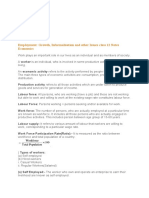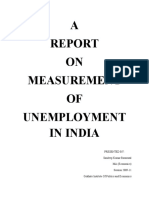The Labour Problem Blog
The Labour Problem Blog
Uploaded by
Dhanashree ChaudhariCopyright:
Available Formats
The Labour Problem Blog
The Labour Problem Blog
Uploaded by
Dhanashree ChaudhariOriginal Title
Copyright
Available Formats
Share this document
Did you find this document useful?
Is this content inappropriate?
Copyright:
Available Formats
The Labour Problem Blog
The Labour Problem Blog
Uploaded by
Dhanashree ChaudhariCopyright:
Available Formats
CHALLENGES OF MANPOWER IN PRINTING INDUSTRY
"The Labour Problem" is a major problem and term widely used toward the turn of the twentieth
century with various applications not only on printing industry but also in all the other industries.
It has been defined in many ways, such as "the problem of improving the conditions of
employment of the wage-earning classes." It encompasses the difficulties faced by wage-earners
and employers whom began to cut wages for various reasons including increased technology,
desire for lower costs or to stay in business. It was a nationwide problem that spanned nearly all
industries and helped contribute to modern business conditions still seen today.
CAUSES:
At the turn of the century machines were beginning to take a stronger footing in the economy,
which drove costs down. Always trying to maximize profits, employers saw fit to lower wages
for two main reasons. Machines were making the production process cheaper meaning wages
took up a bigger percentage of costs, and when times were particularly tough, it made sense to
cut wages to stay in business. This depersonalization of the production process meant that people
essentially became expendable. People were not eliminated completely but there was a
significant jobless. This led to lower wages in the long run because fixed costs decreased (with
increased technology) so employers saw fit to cut wage expenses for this now partially
expendable labour force. Although the problem spanned many industries, they were not all
concerned with the same problems.
SOME MAIN CHALLANGES ARE:
1. Illiteracy: A large proportion of industrial workers in India are illiterates & unaware. So
they cannot understand the problems and the challenges will be faced by the economy in
general & industries. They do not even understand their own problems.
2. Lack of Discipline: There is no discipline among the industrial labours in India
Indiscipline, absenteeism without any reasons. Moving from one job to another etc., are
very common.
3. Majority Characters: Industrial labour in India is migratory in character. Most of the
labourers in industries are drawn from villages and are returned to their homes during
their busy agricultural seasons.
4. Lack of Organizations: The industrial labour in India is not united, but is divided & subs
– divided on the basis of language, region, caste, etc. They are unable to organize
themselves.
5. Low Efficiency: The efficiency of industrial labour in India is very low. Their
productivity is also very low. Lack of education, training, research medical facilities, etc.,
are reasons for low productivity.
6. Poverty: The industrial labours in India are very poor. Their salary, standard of living &
productivity are very low. They are unable to generate interest in their work because of
poverty.
7. Superstitions: Most of the industrial labour in India is superstitions & tradition – bound.
They believe in philosophical & Meta physical things. They have irrational outlook.
8. Large Scale Absenteeism: It is another important feature of industrial labour. They
remain absent without any reason.
9. Ignorant of Roles & Regulations: A good proportion of our industrial workers are
ignorant of rules & regulation.
10. Bad Habits: The industrial labourers in India are addicted to bad habits. They are
involved in unhealthy practices. As a result, their efficiency & mental discipline are badly
affected.
11. Age issues: Like women, older people and children often perform important, non-
economic labour roles which need to be properly evaluated before introducing changes
which might affect them.
12. The community: Assumptions regarding the community's ability to mobilize labour in
order to undertake "development" activities have to be carefully investigated by looking
at patterns of communal labour. This may include periodic work carried out by the
community to assist individuals in carrying out specific tasks such as land clearing or
house building
You might also like
- Project About Unemployment in IndiaDocument12 pagesProject About Unemployment in IndiaAshishSharma86% (65)
- Herzberg's Two-Factor Theory of MotivationDocument3 pagesHerzberg's Two-Factor Theory of MotivationDhanashree ChaudhariNo ratings yet
- Banking DictionaryDocument499 pagesBanking DictionaryVanessa Jenkins100% (6)
- Nalebuff, Barry J. & Adam M. Brandenburger - 'Co-Epetition - Competitive and Cooperative Business Strategies For The Digital Economy'Document10 pagesNalebuff, Barry J. & Adam M. Brandenburger - 'Co-Epetition - Competitive and Cooperative Business Strategies For The Digital Economy'DylanOSullivanNo ratings yet
- Project About Unemployment in IndiaDocument12 pagesProject About Unemployment in Indiavedant bodkhe100% (2)
- s6 Enterpreneurship Paper One Uace Internal Mocks Examination 2020 Kings College BuddoDocument2 pagess6 Enterpreneurship Paper One Uace Internal Mocks Examination 2020 Kings College Buddokabugho aisha100% (3)
- Unemployment in IndiaDocument21 pagesUnemployment in IndiaSagar Nawale73% (37)
- Urbanization and Rural-Urban Migration: Theory and PolicyDocument38 pagesUrbanization and Rural-Urban Migration: Theory and PolicyEphreen Grace MartyNo ratings yet
- Pintura Corporation: The Lena Launch Decision: ProblemDocument2 pagesPintura Corporation: The Lena Launch Decision: ProblemSounakNo ratings yet
- Businessplan: 2 0 2 0 ClassifiedDocument21 pagesBusinessplan: 2 0 2 0 ClassifiedCerasela Badr El-DinNo ratings yet
- Project About Unemployment in IndiaDocument24 pagesProject About Unemployment in Indiaamolchavan2003No ratings yet
- Unemployment in IndiaDocument2 pagesUnemployment in Indiabittu iNo ratings yet
- Unemployment in IndiaDocument23 pagesUnemployment in IndiaAlok Nayak100% (3)
- Final Project Client-1Document50 pagesFinal Project Client-1faithNo ratings yet
- Chapter 7 IedDocument4 pagesChapter 7 IedAkshayaram ViswanathanNo ratings yet
- Paper-Ii: Labour Perspectives in India (Probable Questions)Document21 pagesPaper-Ii: Labour Perspectives in India (Probable Questions)rajnishsinghNo ratings yet
- Industrial Relations: Socio Economic Scenario in View of Labour Force in IndiaDocument6 pagesIndustrial Relations: Socio Economic Scenario in View of Labour Force in Indiamba departmentNo ratings yet
- Unemployment in IndiaDocument16 pagesUnemployment in Indiavicky1810No ratings yet
- Class 12 EMPLOYMENTDocument5 pagesClass 12 EMPLOYMENTAryan ph vlogsNo ratings yet
- Unemployment in India UnemploymentDocument5 pagesUnemployment in India UnemploymentRaj GuptaNo ratings yet
- Q ADocument5 pagesQ AgdhssjjssjNo ratings yet
- A Key Role of The Industrial Sector in Employment ServicesDocument7 pagesA Key Role of The Industrial Sector in Employment ServicesDhumalNo ratings yet
- Adobe Scan 25 Dec 2022Document3 pagesAdobe Scan 25 Dec 2022Archita VermaNo ratings yet
- Economics Project 38Document23 pagesEconomics Project 38MitheleshDevarajNo ratings yet
- XII CHAPTER 12 Socilolgy Yaseer HssliveDocument4 pagesXII CHAPTER 12 Socilolgy Yaseer Hssliveanbarasik15.histNo ratings yet
- Introduction SsiDocument44 pagesIntroduction SsiSheetal IyerNo ratings yet
- UnemploymentDocument12 pagesUnemploymentRavi SinghalNo ratings yet
- Class X CH 2Document9 pagesClass X CH 2Abhinav SirohiNo ratings yet
- MAN Micro ProjectDocument7 pagesMAN Micro Projectumeshsabale.2006No ratings yet
- External Influences On EDDocument18 pagesExternal Influences On EDand1sailorNo ratings yet
- Factories of India: Arthitectural Theory-Research Paper OnDocument2 pagesFactories of India: Arthitectural Theory-Research Paper OnTanyaNo ratings yet
- EmploymentDocument4 pagesEmploymentpeacestudios4No ratings yet
- M3 ReviewerDocument6 pagesM3 ReviewerJeryl Bryan LopezNo ratings yet
- Social IssuesDocument28 pagesSocial Issuessgsagargupta.0602No ratings yet
- Sectors of The Indian Economy Exercise Q-AnsDocument8 pagesSectors of The Indian Economy Exercise Q-AnsazrieenrafiNo ratings yet
- Unemployment AssignmentDocument3 pagesUnemployment AssignmentJaspreet SinghNo ratings yet
- Eco project-UNEMPLOYMENT PDFDocument7 pagesEco project-UNEMPLOYMENT PDFAdiba maazNo ratings yet
- Chapter 7: UNEMPLOYMENT: Definition Of: (United Nations)Document16 pagesChapter 7: UNEMPLOYMENT: Definition Of: (United Nations)Alok RanjanNo ratings yet
- 9 Most Essential Causes of Rural Unemployment in IndiaDocument10 pages9 Most Essential Causes of Rural Unemployment in IndiaAmit VijayNo ratings yet
- Social Security and Other Benefits To Women Under Unorganized SectorDocument14 pagesSocial Security and Other Benefits To Women Under Unorganized SectorBinitha100% (1)
- Unemployment ProblemDocument3 pagesUnemployment Problemshahriar sNo ratings yet
- Damodaram Sanjivayya National Law University Visakhapatnam, A.P., IndiaDocument21 pagesDamodaram Sanjivayya National Law University Visakhapatnam, A.P., IndiaRohan guptaNo ratings yet
- Engg. Economics - Lecture - 5 - Industrial EconomicsDocument32 pagesEngg. Economics - Lecture - 5 - Industrial EconomicsQuizMM MujNo ratings yet
- Economics ProjectDocument7 pagesEconomics ProjectMadhusmita BeheraNo ratings yet
- Labourers of Unorganised Sectors and Their Problems: ChatterjeeDocument10 pagesLabourers of Unorganised Sectors and Their Problems: ChatterjeeRavdeepNo ratings yet
- CBSE Class 12 Sociology Social Change and Development in India Revision Notes Chapter 5Document9 pagesCBSE Class 12 Sociology Social Change and Development in India Revision Notes Chapter 5muntazir.hussain.delNo ratings yet
- Bproblem of PovertyDocument12 pagesBproblem of PovertyCharanKamal Singh SethiNo ratings yet
- Engg. Economics Lecture 5Document11 pagesEngg. Economics Lecture 5vsvsasasNo ratings yet
- Voluntary UnemploymentDocument23 pagesVoluntary UnemploymentSukhdeep Singh Khalsa100% (1)
- ESO16 8 UnemploymentDocument16 pagesESO16 8 UnemploymentSanthosh Kumar0% (1)
- Block 3Document79 pagesBlock 3Samrat PvNo ratings yet
- Grade 10resourceDocument5 pagesGrade 10resourcezayaan.esau04No ratings yet
- Employment 1Document3 pagesEmployment 1kishorepk218No ratings yet
- Measurement of Unemployment in IndiaDocument17 pagesMeasurement of Unemployment in IndiaRitika PradhanNo ratings yet
- EntereDocument9 pagesEnterePawan Arora0% (1)
- Topic 1 Notes-EntrepreneurshipDocument6 pagesTopic 1 Notes-EntrepreneurshipCainan OjwangNo ratings yet
- E: G, I I: Mployment Rowth Nformalisation AND Other SsuesDocument23 pagesE: G, I I: Mployment Rowth Nformalisation AND Other SsuesHarpreetNo ratings yet
- Measurement of Unemployment in IndiaDocument33 pagesMeasurement of Unemployment in Indiasandeepkumarbaranwal100% (3)
- Igsce Econ CH 27Document13 pagesIgsce Econ CH 27agh.jaiganeshNo ratings yet
- Sectors of Indian Economy CH.2 Eco PDFDocument6 pagesSectors of Indian Economy CH.2 Eco PDFtechvyxdNo ratings yet
- Overview of Unemployment Problem in IndiaDocument6 pagesOverview of Unemployment Problem in IndiaAbhimanyu SinghNo ratings yet
- Advantages or Merits of Small Scale IndustriesDocument5 pagesAdvantages or Merits of Small Scale IndustriesMeenakshi Anil0% (1)
- Industrial Relations in Public EnterpriseDocument17 pagesIndustrial Relations in Public EnterpriseAnjali ChauhanNo ratings yet
- Creating New Jobs from the Existing Jobs: An Explicit and Practicable Guide Motivating New Entrepreneurs Towards Creating New JobsFrom EverandCreating New Jobs from the Existing Jobs: An Explicit and Practicable Guide Motivating New Entrepreneurs Towards Creating New JobsNo ratings yet
- Final Notes 307-C Labour Law 1-08-2016Document60 pagesFinal Notes 307-C Labour Law 1-08-2016Dhanashree ChaudhariNo ratings yet
- UNIT 4 Disciplinary ProcedureDocument3 pagesUNIT 4 Disciplinary ProcedureDhanashree ChaudhariNo ratings yet
- Management AuditDocument15 pagesManagement AuditDhanashree ChaudhariNo ratings yet
- NTA UGC NET Environment Questions Part 1Document4 pagesNTA UGC NET Environment Questions Part 1Dhanashree ChaudhariNo ratings yet
- Case StudyDocument17 pagesCase StudyDhanashree Chaudhari0% (1)
- Marginal VaRDocument1 pageMarginal VaRsarafbisesh1No ratings yet
- Bikanerwala VasuDocument17 pagesBikanerwala VasuHEENA GARGNo ratings yet
- Consumer Behaviour Towards Passenger CarsDocument8 pagesConsumer Behaviour Towards Passenger CarsNajeemudeenkpNo ratings yet
- Plan de NegociosDocument3 pagesPlan de NegociosMaria Victoria Olarte LopezNo ratings yet
- SSC CGL Syllabus PDFDocument8 pagesSSC CGL Syllabus PDFPraveen Kumar BadavathNo ratings yet
- Employee Benefits Provided by Majoriy of The BPO CompaniesDocument6 pagesEmployee Benefits Provided by Majoriy of The BPO CompaniesDivya Raman100% (1)
- Suraj Agrawal Tax 1 NotesDocument504 pagesSuraj Agrawal Tax 1 NotesNiraj VyasNo ratings yet
- Money MarketDocument7 pagesMoney MarketShaimon JosephNo ratings yet
- Calamsin Juice "Refreshing Drink" Bryg. Hicantacan La Paz Iloilo City 09173277068Document5 pagesCalamsin Juice "Refreshing Drink" Bryg. Hicantacan La Paz Iloilo City 09173277068Daryl Dave AposagaNo ratings yet
- Agricultral and Commodity Marketing Chapter 2Document11 pagesAgricultral and Commodity Marketing Chapter 2Asaminow GirmaNo ratings yet
- Activity Based Costing ExampleDocument7 pagesActivity Based Costing ExampleMohsin BashirNo ratings yet
- Paper 11446Document7 pagesPaper 11446saranyasenthil0302No ratings yet
- Entrepreneurship 12 Final PDFDocument50 pagesEntrepreneurship 12 Final PDFMarilou SacayanNo ratings yet
- 0 Geographies of Development Anti-Development SyllabusDocument6 pages0 Geographies of Development Anti-Development SyllabusParisTiembiNo ratings yet
- "A Study On Home Loan Practices in Bengaluru": "Master of Business Administration" Bangalore Central UniversityDocument4 pages"A Study On Home Loan Practices in Bengaluru": "Master of Business Administration" Bangalore Central UniversityUDayNo ratings yet
- GK Tornado Sbi Po Main Exam 2019-68Document119 pagesGK Tornado Sbi Po Main Exam 2019-68sasNo ratings yet
- Annual Fraud Indicator 2011Document41 pagesAnnual Fraud Indicator 2011alexstukovNo ratings yet
- Company Profile (1) 2Document22 pagesCompany Profile (1) 2Eze ChidiebereNo ratings yet
- Emmanuel Thanassoulis Auth. Introduction To The Theory and Application of Data Envelopment Analysis A Foundation Text With Integrated SoftwareDocument296 pagesEmmanuel Thanassoulis Auth. Introduction To The Theory and Application of Data Envelopment Analysis A Foundation Text With Integrated SoftwareLeonardo Borges Koslosky0% (2)
- M&A ValuationDocument7 pagesM&A ValuationmithunsworldNo ratings yet
- Pada Konsumen Coffee Shop Atas Kota SemarangDocument14 pagesPada Konsumen Coffee Shop Atas Kota SemarangOde OdeNo ratings yet
- Reading Comprehension Free PDF Set 3 For Bank Prelims ExamDocument7 pagesReading Comprehension Free PDF Set 3 For Bank Prelims ExamAbdulaziz TilahunNo ratings yet
- Leather IndustryDocument23 pagesLeather IndustryChhaya SinghNo ratings yet
- Labour LegislationDocument19 pagesLabour LegislationPalak JainNo ratings yet































































































